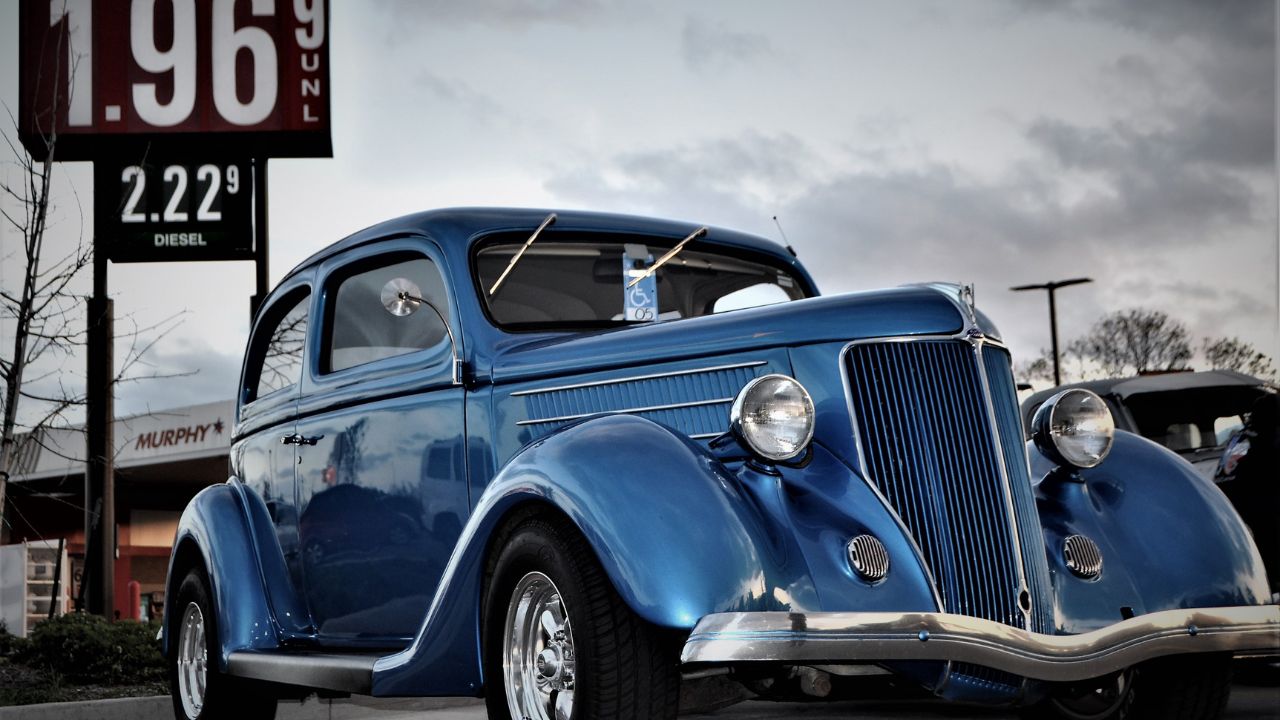
You probably think of the Dodge Charger when you think about 1971 cars. The 1971 Dodge Charger saw a redesign with a 115-inch rim, six coupes and three tops. It also had a much larger interior than either the Ford Torino, Chevy Chevelle, or the Ford Torino. Basic models came in slant six and 318ci engines. You could also choose the Hemi option. Its trim levels were now called the SE and 500, and they added additional features like a three-speed manual transmission, extra sound insulation, carpeted trunk, and wood-grain plastic.
Chrysler's 1971 cars had automatic headlights and tilt wheel
In 1971, Chrysler's lineup consisted of four door sedans, two-door convertible hardtops, as well as wagons. Almost every car in this line featured streamlined fuselage styling and the C-body architecture. There were also improvements in rear footroom and the installation of automatic headlights. Many models were equipped with tilt steering and automatic headlights. Chrysler also started offering automatic transmissions on its cars. This made it easier to drive.

Chrysler's 1971 cars featured automatic temperature control
Automatic temperature control was first introduced on the Chrysler Imperial late in the 1967 model year. This feature was unique in its class, and even the most expensive models had it as an option. This feature was standard on the Ford Thunderbird. Even cheaper cars could have automatic climate control in the 1970s. The era's best cars had this feature, and the sidebar below lists the most popular models.
Ford's 1971 Mustang Mach 1 had partial-throttle Downshift
When the Mustang Mach I was released, it had a unique feature. Ford tested part-throttle Downshifting while racing on the track. Part-throttle downshifting is a part of the car's six-speed transmission, and it lets you accelerate during an upshift. The Mustang GT doesn't have this feature, but it was added to Mach 1
Dodge's 1971 cars used a modified power-steering system to provide better road feel
In 1971, the company introduced a new body style called the Charger. The Coronet had been the base for this car since 1970. However, it was a disappointing success. It was a four-door sedan with only the 318 or 6 engines. The Dodge Coronet was withdrawn and replaced with the Charger, which is a four-door sedan or wagon. The Charger's popularity grew after it was redesigned for the 1971 model year.
GM's 1971 cars had Torsion-Quiet Ride
In 1971, GM introduced the Torsion-Quiet Ride system. It was intended to reduce noise, vibration and stiffness by isolating the leaf springs from their subframe. However, it had many drawbacks when cornering. Rick Ehrenberg is a Mopar expert and recommends retrofitting earlier suspension parts in order to increase performance, reduce noise, and improve handling. But what about the Torsion Quiet Ride system?

Ford's 1971 Mustang Mach 1 received a new 360 motor
1971 Ford Mustang Mach 1 is a sports car. It was made for the first time in 1969. It was replaced by the Mustang GT, and featured a 360 engine. The Ford Mustang Mach 1 won many major races over its lifetime, including the North American Rally Championship. It also won many awards for performance, including "Best of Show" honour.
FAQ
What qualifications do you need to be a mechanic?
You will need to pass several exams in order to become a mechanic. These include:
-
A general knowledge test
-
Practical exam
-
An apprenticeship test
These tests will ensure you are familiar with the fundamental concepts of mechanics and physics before starting to work as a mechanic.
After passing these tests, you will be eligible to become a mechanic. You'll still need an apprenticeship. This will involve trade training.
You'll need to attend classes and workshops to learn everything you need to know about repairing vehicles. It will be necessary to work alongside experienced mechanics.
For mechanic success, you'll need to be focused and meticulous. Repairs to vehicles require you to pay attention to every detail.
To become a successful mechanic you'll need patience. If you don’t like following directions, then this career path may not suit you.
But if you love cars and enjoy fixing them, you could be very happy in this line of work.
What is the distinction between a mechanic or an automotive technician?
These two jobs are very similar but not identical. An automotive technician maintains cars, while a mechanic repairs them.
A mechanic must be skilled in manual dexterity and able to complete simple tasks quickly. They should also be able correctly diagnose and repair any problems.
An automotive technician is required to have more technical knowledge than a mechanic. They should be able read blueprints and use tools like drills and wrenches.
They must also be able to carry out complex procedures safely. They must also be familiarized in different types and electrical systems.
They must also be able comprehend how the various parts interrelate with one another.
As a result, a mechanic usually earns less money than an automotive technician. But there are many opportunities for both jobs.
How can I prepare for a apprenticeship as a mechanic?
Understanding what you're getting into is crucial. It is important to know the basics of how cars work. This way, you know where to start when you go on your first day at the garage.
You should also know how to fix common problems such as tires or broken lights.
This article will show you how to diagnose and fix issues.
For the purpose of putting them back together again, you'll need to be able to identify how each piece fits together.
Finally, it is important to know how tools can be used safely and efficiently.
All these things will help you to become a competent mechanic.
Is being an auto mechanic a promising career choice?
The automotive industry is full of exciting opportunities for those who are dedicated to excellence. Working hard and learning from others is the best way to be successful in this field.
Because you will be spending most of your time communicating with customers and employees, you will need excellent communication skills. It is important that you are willing to travel, work long hours and be able to commute.
If you're interested in pursuing a career in automotive, consider taking classes at community colleges and universities. Many schools offer programs designed specifically for students interested auto repair, sales, and customer services.
You should choose to study mechanical engineering if you want to get a degree. It's possible to get a bachelor's degree in just four years.
Many employers will hire graduates straight out from school. So it's wise to start looking for employment while you still have the chance to study part-time.
After you've finished your education, it's likely that you'll need to go through some training before you can be hired as an auto technician.
This means you'll need to pass exams such as the Automotive Service Excellence (ASE) certification exam. This test covers topics including engine maintenance, brakes, steering systems, suspension, and more.
Once you pass the ASE test, your license can be applied for by the National Institute for Automotive Service Excellence.
Private individuals can have their vehicles repaired with a license. Based on the services rendered, you will receive compensation.
Not all states require licensing. A license is required if you plan on working outside of your home state.
Some states don’t issue licenses until a certain amount has been completed. This could be you.
What is the job description for a mechanic in a car?
For car mechanics, there are three main areas for employment:
-
Automotive repair shops
-
Dealerships
-
Independent garages
Automotive repair shops
Most people think of this as the first step to becoming a mechanic. This is the best way to get started. Either you can work in a shop that is owned by another person or start your own business.
If you are interested in working at a shop you will need to apply for membership to a union. Once you have been accepted into the Union, you'll be given training by the union.
You'll be ready for work once you have completed the training.
Registering with the government is required if you intend to open a garage. After you register, you will be required to meet specific standards.
After you register, you will be granted a license for your garage to operate.
Your license will permit you to sell spares parts and perform minor repairs. It will not allow you to repair major engine problems.
Customers will expect you to not only sell spare parts but also provide advice and guidance.
Dealership jobs
Many dealerships have mechanics who are experts in one particular area. For example, they might only deal with brakes or only replace tires.
However, dealerships may also employ general mechanics who are able to handle all aspects related to car repairs.
These positions often require applicants that they undergo special training before being allowed work. This allows employers to select the most qualified candidates for their roles.
Some dealerships hire students straight out of college. These graduates are already familiar with basic mechanics and can therefore learn about cars.
Independent garages
Independent garages don’t have to be associated with any particular dealer. Instead, they tend to focus on providing high-quality service.
Independent garages don't have to be associated with any particular company. This allows them to offer higher wages. These jobs generally pay better than those at dealerships.
However, independent garages may not be better places to work. Many business owners prefer to own their businesses and not delegate the responsibility to others.
This could lead to you working long hours with little control over your day.
Also, expect to make lower wages than if your job was at a dealership.
It's possible to switch between jobs. You can switch jobs easily if you are interested in working at a dealership. Simply ask your employer if they would be open to hiring you as a mechanic.
Or, if your dream is to work for an independent garage you can contact the owner directly.
Unfortunately, finding a new job can be difficult. You can earn more depending on many other factors.
This could include the type of vehicle that you are working on and whether or not you charge an additional for labor.
What length of an automotive course is it?
An automotive course lasts 3 years.
The first year focuses on theory and learning about cars. The second year is dedicated towards practical training. This includes learning how to drive, fix engine problems, and doing other maintenance jobs around your car. The final year is spent doing a placement at a local garage, which gives you experience in fixing real-world problems.
Statistics
- Apprentice mechanics earn significantly less hourly than mechanics who have completed training, with a median wage of approximately $14.50 an hour, according to PayScale. (jobhero.com)
- According to the BLS, total auto technician employment is expected to exceed 705,000 by 2030. (uti.edu)
- According to the BLS, the median annual salary for automotive service technicians and mechanics in the United States was $44,050 in May 2020. (uti.edu)
External Links
How To
How to diagnose your vehicle properly for repair
The symptoms of your vehicle are the first thing you need to look at in order to determine whether it is in dire need of repairs. These steps will help you diagnose your car properly.
-
Check engine lights. The dashboard light indicators, including the engine light, oil pressure gauge, battery light indicator, coolant temperature gauge and RPM gauge, should be checked. You may have a problem with your vehicle if any of the indicators are flashing for more than a few days.
-
Inspect the tire treads. Tires that are worn can cause issues with handling and braking. The treads of the wheels should be inspected as well. They should look clean and be smooth. It is best to take off the wheels and remove them. Use a flashlight to see how well the treads are worn.
-
You should always monitor the level brake fluid. Keep track of the brake fluid level in your vehicle. This ensures that your brakes work properly. If your brake fluid level is low they might not work properly when you apply pressure.
-
You should test the suspension system. A suspension system is designed to absorb vibrations and shocks. It provides better control and allows smoother acceleration and deceleration. You might notice a wobbly feeling or uncontrollable shaking in your vehicle if it has a problem with its suspension. To test whether your vehicle has a suspension issue, try putting weight on the front or rear axle and observe the movement.
-
Examine the steering column. The steering column connects the steering wheel to all other components of the vehicle. Accidents often damage steering columns. You should replace your steering column if it feels loose or unstable.
-
The exhaust pipe should be observed. The exhaust pipe helps move gases from a combustion chamber into the atmosphere. Exhaust pipes that are cracked or leaking can allow harmful fumes to enter your cabin. Also, if your tailpipe is bent, you should fix it immediately.
-
Take a look at the underside of your hood. If you see anything unusual, take a look under the hood. Leakage of fluids in your engine could indicate that it is leaking. In addition, if you notice an unusual smell coming from your engine compartment, you should contact a professional technician.
-
It is important to inspect the air filter. Your vehicle's air filter collects dust and debris from the outside environment. Dirty air filters can cause your vehicle to run poorly. Replace your air filter regularly.
-
Verify the fan belt. The fan belt is the link between the engine and the transmission. If the fanbel breaks, your engine won't turn. Replacing the belt is simple. All you need to replace the belt is a screwdriver with pliers.
-
Verify the radiator hoses. The radiator hose transports water from radiator to engine. If the hose becomes damaged or cracked, hot liquid can be emitted onto the engine. Repairing the hose is easy with a pair of needlenose pliers or a small wire brush.
-
You should inspect the windshield wipers. Windshield wipers use electricity for snow and rain removal. If they stop working, they could leave streaks on your window glass. Simply change the washer oil to fix the problem.
-
Check the battery cables. Your car's electrical system is powered by batteries. When you replace batteries, make sure to disconnect the negative cable first. Failure to do so can damage your alternator.
-
Check the headlights. Headlights illuminate the road ahead of you. Bad visibility can be caused by headlights that don't work correctly. You can check the bulbs to make sure they aren't burned out.
-
Check the lights. You can warn other drivers if you approach them at night. If one doesn't work, it could distract you and lead to an accident.
-
Check the brakes. Before you get in a car accident, your brakes will be slowing down your vehicle. If your brakes aren't working properly, you may lose control and crash into other cars.
-
Change the oil. The oilkeeps your engine lubricated. It helps keep metal parts from getting too worn down. It is recommended that the oil be changed every other month.